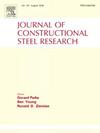地震诱发滑坡作用下高强钢管道腐蚀破坏综合分析
IF 4
2区 工程技术
Q1 CONSTRUCTION & BUILDING TECHNOLOGY
引用次数: 0
摘要
在这项工作中,建立了一个非线性有限元(FE)模型来研究腐蚀和地震诱发的滑坡对高强钢管道破坏行为的协同效应。这项工作集成了永久地面变形(PGD)函数和均匀腐蚀建模方法。研究了高强钢管道在腐蚀、内压和滑坡位移作用下的破坏机理、破坏过程和破坏路径。结果表明,滑坡冲击在腐蚀缺陷处引起了显著的应力集中,引发了破坏。腐蚀管道的最大von Mises应力比完整管道高8 - 54%。在缺陷参数中,腐蚀深度(d/t = 0.1 ~ 0.5)对管道结构完整性的影响大于腐蚀长度(l/Dt=0.5 ~ 2.5)和腐蚀宽度(CW = 0.01 ~ 0.05)。滑坡、腐蚀和内部压力的综合作用进一步加速了管道的破坏。此外,当缺陷局部位于滑坡对侧(95o),轴向位于剪切区中心或靠近滑坡区中心时,缺陷部位最容易发生破坏。在其他情况下,破坏位置转移到位于滑坡中心的管道未受损区域。本文章由计算机程序翻译,如有差异,请以英文原文为准。
A comprehensive failure analysis of corroded high-strength steel pipelines under seismic-induced landslide
In this work, a nonlinear finite element (FE) model was developed to investigate the synergistic effect of corrosion and seismic-induced landslides on the failure behavior of high-strength steel pipelines. This work integrated a permanent ground deformation (PGD) function and uniform corrosion modeling methodology. The failure mechanism, process, and path of high-strength steel pipelines under the action of corrosion, internal pressure, and landslide displacement were investigated. Findings indicated that the landslide impact caused significant stress concentrations at the corrosion defect, triggering failure. The corroded pipeline exhibited 8–54 % higher maximum von Mises stress in comparison with the intact pipeline. Among the defect parameters, corrosion depth (d/t = 0.1–0.5) had a more substantial impact on the pipeline's structural integrity than corrosion length (l/=0.5–2.5) and width (CW = 0.01–0.05). The combined effects of landslides, corrosion, and internal pressure further accelerated pipeline failure. Additionally, failure was most likely to occur at the defect site when the defects was located circumstantially at the landslide-opposing side (95o), and axially at the shear area center or near the landslide area center. In other cases, the failure location shifted to a pipe's undamaged area at the landslide center.
求助全文
通过发布文献求助,成功后即可免费获取论文全文。
去求助
来源期刊

Journal of Constructional Steel Research
工程技术-工程:土木
CiteScore
7.90
自引率
19.50%
发文量
550
审稿时长
46 days
期刊介绍:
The Journal of Constructional Steel Research provides an international forum for the presentation and discussion of the latest developments in structural steel research and their applications. It is aimed not only at researchers but also at those likely to be most affected by research results, i.e. designers and fabricators. Original papers of a high standard dealing with all aspects of steel research including theoretical and experimental research on elements, assemblages, connection and material properties are considered for publication.
 求助内容:
求助内容: 应助结果提醒方式:
应助结果提醒方式:


